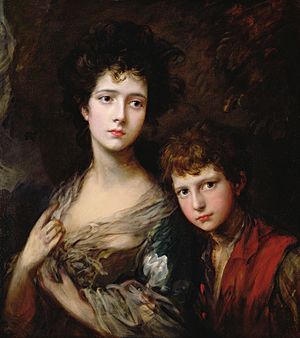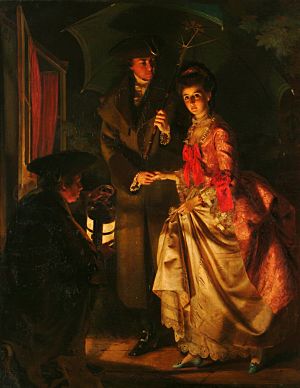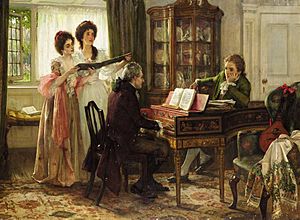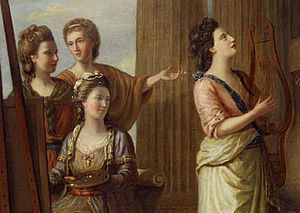Elizabeth Ann Linley facts for kids
Quick facts for kids
Elizabeth Ann Linley
|
|
|---|---|
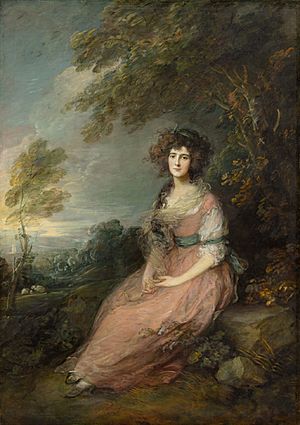
Mrs Richard Brinsley Sheridan, aged 31 (by Thomas Gainsborough, National Gallery of Art)
|
|
| Born | September 1754 Bath, England
|
| Died | 28 June 1792 (aged 37) Bristol, England
|
| Other names | Elizabeth Ann Sheridan |
| Spouse(s) | |
| Children | 2, including Thomas Sheridan |
| Parent(s) |
|
Elizabeth Ann Sheridan (born Linley; September 1754 – 28 June 1792) was a famous English singer. She was known for her great beauty and talent. Many artists, like Thomas Gainsborough and Joshua Reynolds, painted her. Elizabeth was also a skilled poet and writer. She joined the Blue Stockings Society, a group of educated women. She also took part in Whig politics.
Elizabeth was the second of twelve children. Her father, Thomas Linley, was a composer. Her mother, Mary Johnson, was also a musician. Elizabeth married the famous playwright Richard Brinsley Sheridan. She was one of the best soprano singers of her time. However, her husband did not want her to sing in public after they married. She grew up in Bath, where she was born. She likely started singing in concerts when she was nine years old. Her first stage show was in 1767 with her brother, Thomas. A play called The Maid of Bath was made about her life. It was a comedy that made fun of her story.
In 1770, Elizabeth was engaged to a rich, older man. But the wedding was called off. Later, she went to France with Richard Sheridan. They might have gotten married there in March 1772. However, there are no official records of this marriage. The couple came back to Britain in April. They had a formal wedding in 1773. Sheridan defended Elizabeth's honor twice in 1772. He fought duels with a man who had been bothering her.
Elizabeth and Sheridan had a challenging marriage. They had a son named Thomas, born in November 1775. Elizabeth had a daughter on March 30, 1792. Elizabeth had been sick for some time. Giving birth made her illness worse. She died of tuberculosis in June 1792.
Early Life and Singing Talent

Elizabeth Ann Sheridan was born in late 1754. Her exact birth date is listed as September 4, 5, or 7. She was born in Bath. Her father, Thomas Linley, was a musician. Her mother, Mary Johnson, was also a talented musician. Elizabeth was their oldest daughter. Like her brothers and sisters, she was very musical. Her mother taught her at home. She also spent a year or two at a school in Bristol. There she learned French, dancing, drawing, and painting.
Elizabeth probably started singing in concerts when she was nine. She officially performed on stage in 1767. This was at Covent Garden in London. She sang in a show called The Fairy Favour. Her brother, Thomas, played the part of Puck.
Her father was very strict about their performance schedule. He made them perform weekly in Bath, Oxford, and London. Some people thought he made Elizabeth work too hard. They felt she sang songs that were too difficult for her age. Elizabeth was like an apprentice to her father. This meant her performances helped him earn money. Her father carefully chose where she could sing. He wanted her to perform at high-society events. He avoided the London stage to protect her image. She sang at his concerts in Bath. She also performed at the Three Choirs Festival. This festival included tours in Gloucester, Hereford, and Worcester. She also sang in Cambridge, Chester, and Salisbury. These tours were grand events. Elizabeth and other performers had to entertain for hours. This happened before each concert.
Her father chose special songs to make Elizabeth famous. He picked classic songs by Handel. He avoided popular songs of the time. One famous performance was in May 1768. She sang as Galatea in Acis and Galatea. This song became a regular part of her shows. Critics said her voice was clear, sweet, and natural. It was perfect for Handel's style. People also said she behaved just like her voice sounded. This made the public admire her even more. For a time, she was the most celebrated singer in England. People adored her like a celebrity. William Jackson, a composer and family friend, wrote music just for her.
Elizabeth's brother and father also wrote music for her. William Jackson's Twelve Songs and Twelve Canzonets were made for her young voice. Newspapers advertised Elizabeth as a soloist. She sang in a concert on November 26, 1767. Her brother Thomas wrote a song for her final public show. It was called In yonder grove. She wrote the words for this song. The song showed off her amazing vocal range. Many of her songs mentioned birds. This was to highlight the beautiful, natural sound of her voice. King George III saw her perform. He was so impressed that he invited her family to Buckingham Palace. They entertained the Queen in April 1773. The private concert lasted five hours. The King paid her father £100.
Elizabeth met Richard Brinsley Sheridan in October 1770. His family had just moved to Bath. The Sheridans were invited to the Linley home. Elizabeth's father wanted to impress Richard's father. Richard wanted help finding new students. Soon, the teenagers in both families became close friends. At the end of 1770, Elizabeth was engaged to Walter Long. He was an older, wealthy man. But the engagement ended just before the wedding.
There are different stories about why it ended. Some say Elizabeth's sister-in-law told Long she would not be happy. Others say a play called The Maid of Bath caused the break. This play opened in June 1771. It was a comedy that made fun of Elizabeth's story. It was very popular but made Elizabeth feel ridiculed. Some reports say Long was bothered by all the attention Elizabeth received from other men. Whatever the reason, the engagement was broken. Long paid her £3,000 in 1771. She also received £1,000 worth of clothes and jewelry.
Elizabeth continued to get unwanted attention from men. She became scared of those who tried to court her. Richard's older brother, Charles Sheridan, was one of them. She also felt mocked by The Maid of Bath play. Her father and William Herschel had a public fight. It was about whether she would sing at Herschel's event. Their arguments were published in newspapers in January 1772. Elizabeth's life became very difficult. She wanted to escape. She talked to her friend Alicia Sheridan. They made a plan to run away to a convent in France. Alicia thought it was romantic. But she wanted to talk to Richard first. She did not know he also had strong feelings for Elizabeth.
In early March 1772, Elizabeth became more upset. She had headaches and argued with her father. She refused to perform. The three friends planned their escape. Elizabeth pretended to be sick on March 18. This way, she would be left alone at home.
Escape to France
On March 18, Elizabeth stayed in bed. She said she had a headache and was too sick to perform. After her family left for a concert, Alicia arrived. She helped Elizabeth pack her things. Sheridan came to pick Elizabeth up. A female servant went with them as a chaperone. The young couple left for France. They might have gotten married there that month. But no official record exists. The exact details of their escape are not fully known. They first went to London. There, they left the chaperone. They tried to get money from Sheridan's friends. They had very little money. Alicia had given them a small amount. Elizabeth had about £40 saved. They did not get more money. But a friend of Sheridan's helped them get on a ship to Dunkirk.
After a rough sea trip, they took a coach to Calais. They stayed in an inn there for at least one night. Then they took another coach to Lille. They planned to go to a convent in St Quentin. But Elizabeth had been sick since the sea journey. Her condition got worse in Lille. An English doctor and his wife cared for her. Elizabeth started to get better. But the doctor saw early signs of tuberculosis. Sheridan stayed with her. They talked a lot about their lives and dreams. Elizabeth realized her feelings for him were very strong. She wanted to support him, even though he had little money.
Meanwhile, in Bath, Thomas Linley was very upset. He found out Elizabeth was gone with Sheridan. He tried to keep it a secret. But the news spread quickly. Linley received a letter from Sheridan. It described how a man named Mathews had bothered Elizabeth. Linley might have waited to get her back until Mathews left Bath. When people learned about Mathews' actions, he lost support. He placed an advertisement in the Bath Chronicle on April 9, 1772. It spoke badly of Sheridan. Mathews left town a few days later.
The young couple stayed in France for about a month. They returned around April 29, 1772. Elizabeth's father had found them and visited them. He wanted Elizabeth back home for her concerts. He finally understood the trouble Mathews had caused her. Linley agreed to some of Elizabeth's demands. She wanted less work. She wanted to choose when she performed. She also wanted to be able to go back to France after her scheduled concerts.
On their way back to Bath, they stayed in London. Sheridan secretly left to find Mathews. He found him in his home. Mathews lied to Sheridan about the newspaper advertisement. He convinced Sheridan it was not insulting.
When they arrived back in Bath, Sheridan went to the newspaper office. He checked the advertisement's true content. He then arranged with his brother to go back to London. He challenged Mathews again. A short duel happened on May 4, 1772, in London. They agreed to fight in Hyde Park. But it was too crowded. They went to a tavern and then to the Castle Tavern. Mathews lost his sword. He begged for his life. He then signed a paper saying he took back his advertisement. This apology was made public. Mathews was angry about the publicity. His friend encouraged him to fight again. Sheridan did not have to accept. But he would have been shamed if he did not.
The second duel was in July 1772 near Bath. It was much more violent. Both men broke their swords. But they kept fighting for their "life and honor." Both were hurt. Sheridan was badly injured. Elizabeth was performing in Oxford and Cambridge. She did not know about the duels until later. Eight days after the duel, the Bath Chronicle said Sheridan was out of danger.
The duels made Elizabeth's and Sheridan's fathers decide to keep them apart. Elizabeth stayed in Bath. She was overworked but kept at home. On August 28, Richard was sent to Waltham Abbey. The plan was for him to study law. Once separated, their feelings for each other began to fade. Linley encouraged other rich men to court Elizabeth. She refused Sir Thomas Clarges in December 1772. She also rejected Thomas Norris. Sheridan also had other relationships. But in February 1773, he learned Elizabeth was performing at Drury Lane. It was close to where he was. Their romance started again.
The details of what happened in April 1773 are unclear. But Sheridan was now 21. He was legally an adult. He convinced Elizabeth's father to let them marry. Sheridan's father was in Ireland and was not told.
Marriage and Public Life
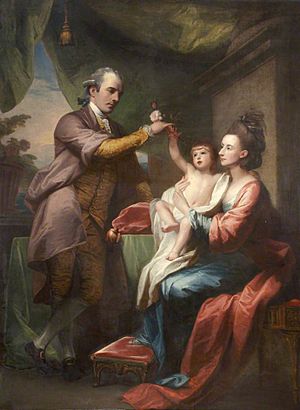
Sheridan and Elizabeth officially married on April 13, 1773. The wedding was at St Marylebone Parish Church. At this time, Elizabeth was called "the best English singer" by Frances Burney. Later newspapers called their courtship "one of the classic romances." They said she was "the most beautiful singer in England." Sheridan came from a poor family. Like his father, he often had money problems. After they married, Sheridan would not let Elizabeth perform professionally. He felt it would hurt his image as a gentleman. Elizabeth worried about their money. Their income was very small. She begged her husband to let her keep singing. It was their only way to earn money.
Part of Elizabeth's dowry was £1,000. This money came from the payment she received from Walter Long. It was used to buy a house in London. Another £1,050 of Long's money was held in trust. Elizabeth received only £31 and ten shillings a year from its interest. Finally, Sheridan allowed Elizabeth to perform. She sang at the Three Choirs Festival in Worcester in September 1773. Her father arranged the profitable contract. But Sheridan insisted she give the £100 fee to charity. He wanted to be seen as a gentleman. Throughout their marriage, Sheridan borrowed a lot of money. This was to support their expensive lifestyle.
They spent summers as guests in grand homes. These included Chatsworth House, home of Georgiana Cavendish, Duchess of Devonshire. They also stayed at the home of banker Stratford Canning. Elizabeth would sing each evening for the guests. This helped them save on living expenses. When they were home, Sheridan held private parties twice a week. Aristocrats came to hear Elizabeth sing. Sometimes her sister, Mary, joined her. Even though he said she would not perform in public, he charged guests.
Elizabeth was invited to these noble homes because of her singing. But people thought her husband was not important. Elizabeth loved these visits. She made close friends with many hostesses. She was especially happy that Sheridan started to be accepted. His cleverness was admired at dinner parties. Historian Joseph Roach called them the "most glamorous couple of the 1770s and 1780s."
Elizabeth and the Duchess of Devonshire became good friends. Georgiana's London home was a center for social events. It was also a hub for Whig politics. This introduced the Sheridans to important politicians. These included Charles James Fox and Edmund Burke. By 1780, Sheridan wanted to work in politics. Elizabeth fully supported him. In 1784, Fox was trying to win his Westminster seat. Elizabeth, Georgiana, and her sister campaigned for him. This event caused some scandal. A drawing showed Georgiana kissing meat sellers for votes. There was a lot of gossip. But Elizabeth's reputation was not harmed. She was not mentioned in the negative pamphlets. People only joked about her sweetness being irresistible.
As her husband's political career grew, Elizabeth became more involved. Sheridan was a favorite of the Prince of Wales. The Prince often ate dinner with them. Elizabeth helped prepare and edit Sheridan's speeches. In 1788, during a political crisis, Elizabeth did much work. She helped write and revise the Prince's reply to William Pitt.
The Sheridans had a difficult marriage. They were not a good match. Sheridan liked city life. Elizabeth loved the countryside. After some difficulties, they had a son, Thomas (Tom). He was born in November 1775. Sheridan and Elizabeth both had other relationships. They spent a lot of time apart. By 1790, Elizabeth was 36 and showing signs of illness. But she had to keep up appearances in London society. While visiting Devonshire House, Elizabeth met Lord Edward FitzGerald. She had a daughter who was born on March 30, 1792. The birth made Elizabeth's illness worse. She died of tuberculosis on June 28, 1792. Elizabeth was buried at Wells Cathedral on July 7, 1792.
Poetry and Writing Skills
Elizabeth was not only a great singer. She also had other artistic talents. She could sketch, mimic people, and play musical instruments. She was also a skilled writer and poet. She often used poetry to express her feelings during sad times. Her younger brother, Tom, died in 1778. He fell from a boat into a lake. Elizabeth wrote a poem about his lyre (a musical instrument). This poem was shared widely. It was later printed in The Annual Register in 1785. She also wrote a poem about her sister Mary's death in 1787. Mary died from tuberculosis. Elizabeth and Sheridan often wrote letters to each other in verse. David Garrick, a famous actor, also wrote to her. He called her The Saint.
After they married, Sheridan gave up his law career. He tried to earn money as a journalist. He knew Elizabeth was a great writer. He convinced her to help him write for newspapers. He even said her writing was better than her singing. Her skills were also needed when Sheridan bought shares in the Theatre Royal, Drury Lane. Elizabeth handled the administration, bookkeeping, and secretarial work for the theater. She advised her husband on which singers to use. When he received too many scripts, Elizabeth read them all. She then recommended what Sheridan should do. Elizabeth also chose the music for the King's Theatre. This was after her husband became involved there.
Sheridan's letters show Elizabeth helped with the music for The Duenna. His biographers say she helped write several of his plays. In his 1825 book, Memoirs, Thomas Moore wrote that Elizabeth's sister believed she wrote the ending for The Rivals. Moore also said Elizabeth wrote a show called "the Haunted Village." Michael Kelly claimed Elizabeth adapted the play Richard Coeur de Lion. In a letter from 1782, Elizabeth said she was working on a book. But no more details about it exist.
Years after her death, a magazine published a letter. It claimed Elizabeth wrote it to a friend. But it was later proven to be fake. It did not sound like Elizabeth's real letters. Her granddaughter, Caroline Norton, said it was not real in 1861. Other fake letters also appeared in newspapers around that time.
Famous Portraits
By her teenage years, Elizabeth was known for her singing and beauty. Thomas Gainsborough was a family friend since 1759. He painted several portraits of the Linley family. His painting The Linley Sisters was made around 1772. It shows Elizabeth and her sister Mary Linley before Elizabeth ran away. This is the only known painting of the two sisters together. Gainsborough felt a special connection with Elizabeth. He seemed to understand her thoughts. His later portrait of her is called Mrs. Richard Brinsley Sheridan. It was painted after her marriage. It shows 31-year-old Elizabeth on a rock in a countryside setting. This reflects her love for rural life.
Elizabeth was also the model for Joshua Reynolds' painting St Cecilia. It was shown at the Royal Academy in 1775. Reynolds called it "the best picture I ever painted." Reynolds also became friends with the Sheridans. He had once invited them to a dinner party. He expected Elizabeth to sing and even bought a new piano. He was upset when they refused to sing in public. She was also the model for the Virgin Mary in his painting of the nativity scene. This painting was later destroyed in a fire.
Richard Samuel included Elizabeth in his group painting. It was called Portraits in the Characters of the Muses in the Temple of Apollo (1778). This painting showed the founders and members of the Blue Stockings Society. It was first shown in 1789. Now it is in the National Portrait Gallery in London.
The painting was popularly called The Nine Living Muses of Great Britain. It showed famous artists and writers. These included poet Anna Laetitia Barbauld and scholar Elizabeth Carter. It also featured playwright Elizabeth Griffith and historian Catharine Macaulay. Three writers were also in it: Elizabeth Montagu, Hannah More, and Charlotte Lennox. Elizabeth was shown as a classical muse. She was placed in a central spot in the painting. This showed her special place among the "bluestocking" women. Even though she was in the painting, Elizabeth was not officially a member of the group.
In 1860, Jerry Barrett showed two paintings at the Royal Academy. They showed Elizabeth and Sheridan during their romance. One painting was called The Elopement. It showed the night they ran away. Elizabeth is being helped from her chair by Sheridan. The other painting was Sheridan, disguised as a hackney coach driver, sees Miss Linley home from Covent Garden Theatre. This painting was used in a newspaper in 1940. Both artworks are at the Brighton Museum & Art Gallery.
Legacy
After Elizabeth died, Sheridan kept his promise. He took care of her baby daughter, Mary. A nurse cared for the child at his home. The baby had fits and died in October 1793. She was 18 months old. She was buried next to her mother at Wells Cathedral.
Elizabeth's son, Thomas, tried to have a political career. He also served briefly in the army. He then married Caroline Henrietta Callander. His father gave him a share of the Drury Lane Theatre in 1806. He became a manager there. He also managed the Lyceum Theatre, London. Like many in his family, Tom also had tuberculosis. He moved abroad to help his health. He became the Colonial Governor's treasurer in 1813. He died on September 12, 1817.
Music historian Charles Burney wrote about Elizabeth Sheridan. He said: "Her voice had a brilliance, spirit, and sweet sound. It instantly touched the hearts of her listeners. Her beautiful looks also delighted their eyes. Her trills were perfect, her singing was true, and her voice could handle any difficult or fast music." Music critic Stanley Sadie said Elizabeth had "one of the sweetest and most expressive soprano voices of her time."
On February 4, 1956, a plaque was placed on the Linley family's former home. It is at 11 Royal Crescent, Bath. The bronze plaque was made by the town. It remembers Elizabeth and Sheridan's elopement. The words on the plaque say: "Thomas Linley lived here and from this house his daughter Elizabeth eloped with Richard Brinsley Sheridan on the evening of 18th March, 1772."
Images for kids


